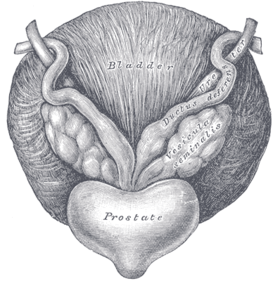Prostatectomy
| Prostatectomy | |
|---|---|
| Intervention | |

Anatomy of the prostate
|
|
| ICD-9-CM | 60.2-60.6 |
| MeSH | D011468 |
Prostatectomy (Greek, -prostates, "prostate", combined with the suffix -ektomē, "excision") is a medical term for the surgical removal of all or part of the prostate gland. This operation is done for benign conditions that cause urinary retention, as well as for prostate cancer and other cancers of the pelvis.
There are two main types of prostatectomies. A simple prostatectomy (also known as a subtotal prostatectomy) is when only part of the prostate is removed. Simple prostatectomies are typically only done for benign conditions. A radical prostatectomy, the removal of the entire prostate gland, the seminal vesicles and the vas deferens, is performed for malignant cancer.
There are multiple ways the operation can be done: as an open surgery (with a large incision through the lower abdomen), laparoscopically with the help of a robot (a type of minimally invasive surgery), through the urethra or through the perineum.
Other terms that can be used to describe a prostatectomy, include
Indications for removal of the prostate in a benign setting include acute urinary retention, recurrent urinary tract infections, uncontrollable hematuria, bladder stones secondary to bladder outlet obstruction, significant symptoms from bladder outlet obstruction that are refractory to medical or minimally invasive therapy, and renal insufficiency secondary to chronic bladder outlet obstruction.
A radical prostatectomy is done in the setting of a malignancy i.e. cancer. For prostate cancer, the best treatment often depends on the risk level of the cancer. For most prostate cancers classified as 'very low risk' and 'low risk,' radical prostatectomy is one of several treatment options (including radiation and active surveillance). For intermediate and high risk prostate cancers, radical prostatectomy is often recommended in addition to other treatment options. Radical prostatectomy is not recommended in the setting of known metastases, when the cancer is known to have spread through the prostate to the lymph nodes or other parts of the body. Prior to decision making about the best treatment option for higher risk cancers, imaging using CT, MRI or bone scans are done to make sure the cancer has not spread outside of the prostate.
...
Wikipedia
